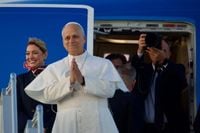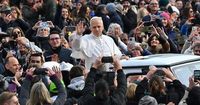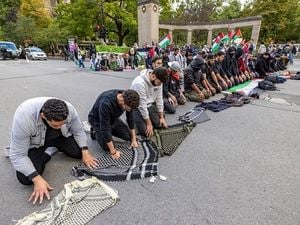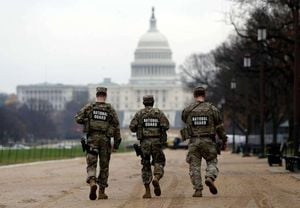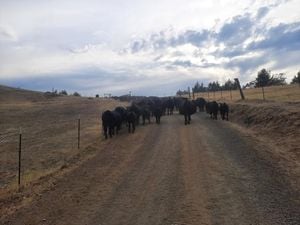On the brisk morning of November 27, 2025, Pope Leo XIV set out from Rome’s Fiumicino Airport, embarking on his first foreign journey as the leader of the Catholic Church. His six-day itinerary would see him land first in Turkey—a nation where Christians make up a mere fraction of the population—and then travel onward to Lebanon, the Middle Eastern country with the highest proportion of Christians. The trip, rich in symbolism and historical resonance, was closely tracked by 81 accredited Vatican journalists and accompanied by a retinue of high-ranking Vatican officials, including four cardinals and two archbishops.
Pope Leo’s journey began with a nearly three-hour flight to Ankara, Turkey’s capital, where he touched down at 12:30 p.m. local time. According to EWTN News, the pope was welcomed by a government minister and a guard of honor at Esenboğa International Airport. His first stop: the mausoleum of Mustafa Kemal Atatürk, the founder of the modern Turkish Republic. This gesture, as CNA noted, immediately recalled the legacy of St. John XXIII, who helped bridge East and West during his time as a Vatican diplomat in Turkey decades earlier.
From the mausoleum, Pope Leo proceeded to the presidential palace for an official state welcome, where he met with Turkey’s president, Recep Tayyip Erdoğan. The two leaders addressed an audience of state authorities, civil society representatives, and members of the diplomatic corps. However, the pope would not linger in Ankara; that very evening, he flew to Istanbul, the sprawling city straddling Europe and Asia, which would serve as his base for the next three nights.
Turkey, home to 87 million people, is overwhelmingly Muslim—more than 99 percent of the population—while Christians account for just 0.2 to 0.4 percent. Ahead of the papal visit, a report from the European Centre for Law and Justice warned of "legal, institutional, and social hostility" toward Christians in Turkey, including restrictive laws, property confiscations, and rising violence. As EWTN News reported, the pope’s presence was seen as a source of encouragement for this embattled minority. Masses were offered for him across the country, including at St. Anthony of Padua’s Basilica, Istanbul’s largest Catholic church.
The following day, November 28, Pope Leo met with Turkey’s Catholic bishops, clergy, and pastoral workers at the Cathedral of the Holy Spirit. He then visited a center for the elderly run by the Little Sisters of the Poor, greeting some 500 staff and collaborators. Later, he traveled by helicopter southeast to Iznik—ancient Nicaea—where he was welcomed by Ecumenical Patriarch Bartholomew I. Together, they led an ecumenical prayer service at the ruins of the Basilica of St. Neophyte, commemorating the 1,700th anniversary of the First Council of Nicaea, a landmark event that shaped core Christian doctrines. As America Magazine reported, Pope Leo’s apostolic letter, "In Unitate Fidei" ("In the unity of faith"), emphasized the shared declaration of faith that still unites Christian churches worldwide. The motto for his visit, "One Lord, one faith, one baptism," underscored this call for unity.
On November 29, the pope visited Istanbul’s iconic Blue Mosque, a 400-year-old masterpiece renowned for its dazzling blue tiles. There, he was received by the head of the Diyanet, Turkey’s religious affairs directorate. He then met with the heads of Christian churches at the Syriac Orthodox church of Mor Ephrem—the only church built in Turkey since the republic’s founding in 1923. Later that afternoon, Pope Leo joined Patriarch Bartholomew at the Patriarchal Church of St. George for the Doxology, a hymn of praise. The two leaders then signed a joint statement at the Patriarchal Palace, reinforcing the bonds between Catholicism and Orthodoxy. That evening, the pope presided at Mass at the Volkswagen Arena for 4,000 faithful, delivering his homily in English.
Sunday, November 30, marked the final day of the Turkish leg. Pope Leo prayed at the Armenian cathedral before attending Divine Liturgy at the Patriarchal Cathedral of St. George, where he spoke and, alongside Patriarch Bartholomew, imparted an ecumenical blessing. After a private lunch with the patriarch, the pope departed for Beirut, Lebanon, beginning the second stage of his journey.
Lebanon, a nation of over five million, stands as a unique mosaic of faiths—30 to 33 percent Christian, the remainder mostly Muslim. Yet the country has been battered by conflict, economic crisis, and a recent spate of violence. Just days before the pope’s arrival, an Israeli airstrike in Beirut killed a Hezbollah leader and four others, injuring 28, despite a ceasefire agreement signed in November 2024. As America Magazine reported, Maronite Bishop George Bacouni remarked, "The Holy Father is coming at a very difficult moment for Lebanon and for our region. People are worried about the future. Many are suffering from the economic crisis, from instability and from fear because of the situation around us."
Pope Leo’s arrival in Beirut on November 30 was met with immense joy—and heavy security. He received a state welcome, complete with a military guard of honor and a 21-gun salute. Lebanon’s president Joseph Aoun, National Assembly president Nabih Berri, Prime Minister Nawaf Salam, and Maronite Patriarch Cardinal Béchara Boutros Raï all greeted him at the airport, reflecting the country’s delicate sectarian balance. The pope’s address to 400 political, religious, and civil leaders focused on peace—not just for Lebanon, but for the wider Middle East.
During his three-day stay, Pope Leo visited key Christian sites, met with bishops, clergy, laity, and young people, and engaged in interfaith dialogue. On December 1, he traveled to the Maronite Monastery of Saint Maron to pray at the tomb of St. Charbel Makhlouf, a figure revered by both Christians and Muslims. He then visited the shrine of Our Lady of Lebanon at Harissa, addressing hundreds of clergy and pastoral workers. That afternoon, he participated in an ecumenical and interreligious gathering at Beirut’s Square of the Martyrs, before heading to Bkerké for an evening meeting and prayer with thousands of young Lebanese.
December 2 brought a somber moment: the pope visited a hospital for the sick and elderly, then prayed in silence at the memorial for the victims of the 2020 Beirut Port explosion, which killed over 200, injured more than 700, and left 300,000 homeless. As Bishop Bacouni told reporters, "The prosecutor has been stopped in his investigation and the judiciary system is not working due to the interference of the politicians. The victims have a right to know the truth." The Catholic Church remains a lone voice pressing for justice.
The climax of the visit was a Mass at Beirut Waterfront, attended by an estimated 100,000 people, including 3,000 Catholics from Syria. Afterward, Pope Leo departed for Rome, holding his first press conference as pope during the flight, before landing at Leonardo da Vinci airport at 4:10 p.m.
For both Turkey’s minuscule Christian community and Lebanon’s battered but resilient faithful, Pope Leo XIV’s journey offered a powerful message of unity and hope—one that will echo long after the papal plane’s wheels touched down in Rome.
